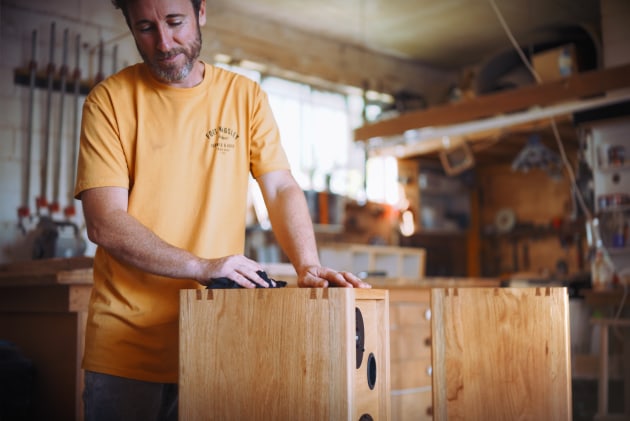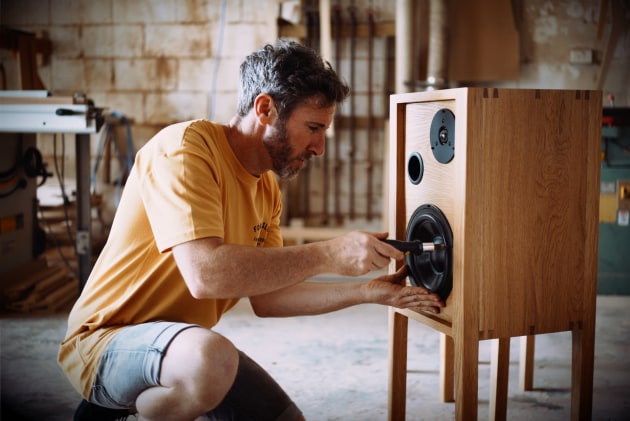Liam McCallion's 'sound' work
Liam McCallion in his workshop in Burleigh Heads, Qld.
Words: Liam McCallion
Workshop photos: Karl Mason
Cabinet photos: Liam McCallion
I’ve been working with my hands for the best part of 20 years, building boats, homes, engines and machines. I love being able to produce beautiful things that bring new experiences to people but it is the rhythm of seeing these things emerge from nothing but an idea or a vision that really propels my work. It is no surprise then that music has always held a defining role in how I work; whether it is holding my focus or building my momentum, it is an element that underpins the rhythm of my projects all the way from concept to completion.
From a very young age I was drawn to music, not only music but the way sound is delivered. I think I was an audiophile before I knew what the term audiophile was. Music and sound have always been a constant in my mind, and over the years timber and aesthetically pleasing design have also come to the surface. These days all three are occupying my mind most of the time!
A lot of inspiration for timber use and design stems from being an admirer of audio consoles that commanded pride of place in living rooms of the sixties to seventies. These were statement pieces that didn’t only look and sound good but brought family and friends together. As technology has advanced, these pieces that boasted both form and function have become a thing of the past. But having new technology doesn’t have to mean missing out on timeless design – they complement each other so well, and I am determined to give more people the option of enjoying this ‘future-classic’ combination.
The author shown fitting speakers, here for a small audio unit. Finding the right combination of electronics and equipment has been a journey. ‘Wiring an integrated amplifier has been the biggest challenge.’
It all really started in 2015, while helping a friend in his factory making furniture that predominantly used reclaimed timbers. This was my introduction on how to overcome the challenges and nuances that solid timber often produces. After successfully finishing multiple projects, I was fortunate enough to be offered a permanent space in this workshop, giving me access to all the tools and machinery necessary to begin the Fort Kingsley journey.
Around the same time, I regularly found myself at Designsmith, a local furniture studio on the Gold Coast. The owner, Graeme Smith, specialises in furniture restorations from the mid-century modern era. When you walk into his store, you’re surrounded by unique furniture that’s both humbling and inspiring in its beauty and craftsmanship. Graeme is a larger- than-life character who has a true passion for design and community, he has gone above and beyond to support the inception of this endeavour. The timing of the events and opportunities were impeccable and seemed more like fate than chance.
My first major piece had to be an audio console. If I had a chance to go back in time, I would probably slap myself – I had no idea what I was delving into. I’ve come a long way since then, after extraordinarily long hours, costly mistakes, blood, sweat and many tears, I am close to being as happy as a perfectionist can be with my designs.

Liam McCallion’s Crombie audio console in spotted gum combines modern technology with traditional means. ‘I always look forward to shaping the wave finger pull handles.’
I now have two audio console designs and stand-alone speakers in my slowly growing furniture range. The latest being the Crombie. The aim of the Crombie design was to keep it clean and minimal, while adding subtle detail. The base and legs are from a drawing I have used many times over the years. I still have the original sketch from the early days and I keep returning to it. It is one of those designs that I just never get tired of visiting – it works really well to meet all kinds of different needs. It uses a waterfall-mitred construction and has wave finger pulls. I always look forward to shaping these handles.

The built-in turntable incorporates a hand-wired British-made Rega tonearm.
This project was in the workshop for the best part of a year because I wanted to find the perfect door for the record storage that would bring the final piece together. I was determined to find something that wouldn’t be in the way when opened, eliminating the trip hazards that drawers or doors often present because they are designed in most cases for functional closure and not for working within spaces while they are open. I finally found a pocket door hardware that allows it to tuck in, leaving your record collection on display while in use. I love the thought of having all that music and art on display to bring another element of joy to the room while music is playing.
However in this current technological climate, I expect that the console will mainly be used for streaming music. This is why I ensured that the controls are still accessible without having to open the lid, unless of course you’re spinning vinyl. This means that the console can effortlessly pair with your phone, tablet or computer to allow complete multi-platform functionally as new streaming tech continuously enters our lives.
From an aesthetic perspective, I personally love the look of the controls on display, along with the speaker drivers. I mean, why would you want to hide something so special?

Wiring an integrated amplifier, as you might imagine, has been the biggest challenge. There have definitely been some tears while figuring out how to jump the many hurdles that the electronic requirements put in front of me! Finding the right solution wouldn’t have been possible without my friend George Newbold, who is an electronics wizard and was able to steer me in the right direction. Together, we played a game of trial and error that went on for a year or two but after sourcing many different components and parts, we finally ended up with a perfect combination.
The result is a 300 watt D class amp and phono stage, powering a pair of two-way bass reflex speakers using eight-inch woofer drivers and 11/8 tweeters. The turntable section features a hand wired tonearm by renowned 45-year-old British manufacturer Rega. The plinth has an isolated design to prevent any unwanted vibrations, interference or feedback, it enables Wi-Fi streaming and there are two auxiliary inputs to plug into.
It’s been quite the ride and I’m reminded of this every time I finish and test an audio piece with a grin. I am extremely grateful that I have been given the opportunity to make pieces like this for people and see the smiles on their faces when hearing their favourite LP through one of my handmade consoles. It really is a dream come true.
Liam McCallion specialises in furniture and audio from his studio/ workshop in Burleigh Heads and strives to create unique yet functional pieces combining his love for timber, design and music. Learn more at www.fortkingsley.com and Instagram @fortkingsley




